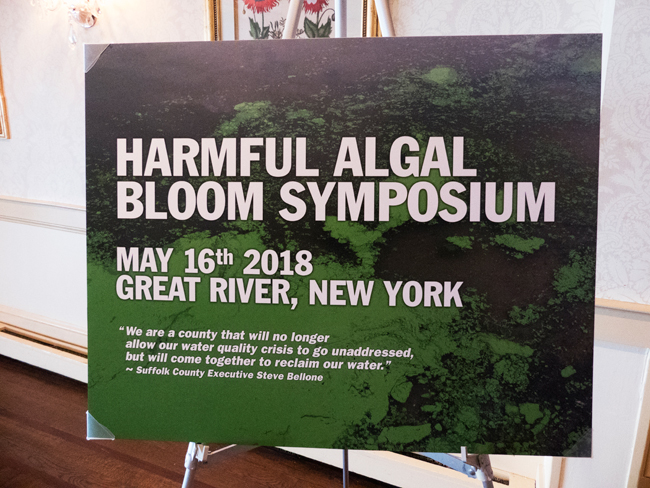
Credit: Ryan Strother / NYSG.
Foreword
The inaugural Harmful Algal Bloom Symposium was held on May 16, 2018 at the Timber Point Country Club, Great River. The NOAA National Centers for Coastal Ocean Science provided funding for the Symposium through an Ecology and Oceanography of HABs (ECOHAB) award to Dr. Christopher Gobler, a researcher and faculty member at the Stony Brook University School of Marine and Atmospheric Science (SoMAS). ECOHAB funds research to understand the causes and impacts of HABs and their toxins, which is fundamental to successful management and mitigation. ECOHAB was authorized by the Harmful Algal Bloom and Hypoxia Control Act (HABHRCA) in 1998 and reauthorized in 2004 and 2014. Through this project, New York Sea Grant will organize two technical harmful algal bloom meetings to support the goals established for ECOHAB.
The focus for this first meeting was a public presentation of the Suffolk County Harmful Algal Bloom Action Plan (Plan), which was prepared by New York Sea Grant under contract to Suffolk County, as a guide to neutralizing the impacts of the growing threat of harmful algal blooms. By supporting this meeting, ECOHAB is providing preliminary assistance to directly address the Plan recommendation for, “Biannually, the HAB Management Group should hold a public forum to present information to the general public on HABs in County waters, their recent history and anticipated future outbreaks” (pg 52). Suffolk County will continue these public forums in future, to convey updates about the Plan implementation.
One hundred and two people registered for this symposium, with attendance drawn from various stakeholders representing agriculture, nurseries, septic waste disposal, fishing, seafood, research, agencies, education, extension, environmental advocacy, and homeowners.
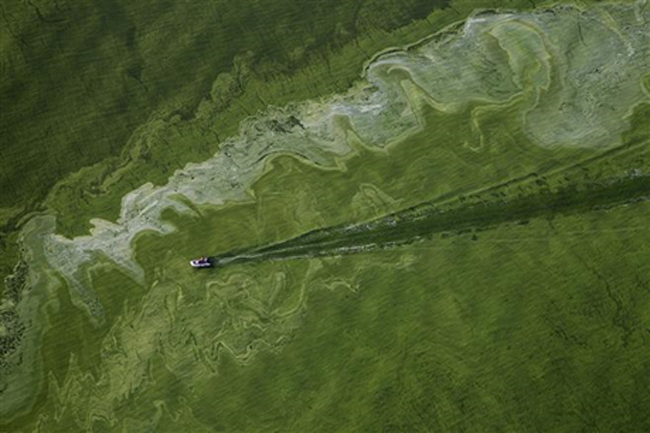
HAB affects coastal embayments and causes significant disruption and economic loss. Credit: James Ammerman, NEIWPCC/LISS.
The severity and incidences of harmful algal bloom outbreaks have continued to increase in occurrence and severity, especially in Suffolk County over the years. With the significant increase in occurrences recorded in Suffolk County during the past decade, harmful algal blooms can result in shellfish harvesting and/or bathing beach closures. This disruption results in significant economic loss to the fishing industry and outdoor recreation sectors.
The Suffolk County Harmful Algal Bloom Action Plan is available online (pdf), accompanied by a technical support document containing a comprehensive history of HABs in Suffolk County. The Plan may be subject to revision in future as Suffolk County evaluates the management progress and the resource response under this initiative.
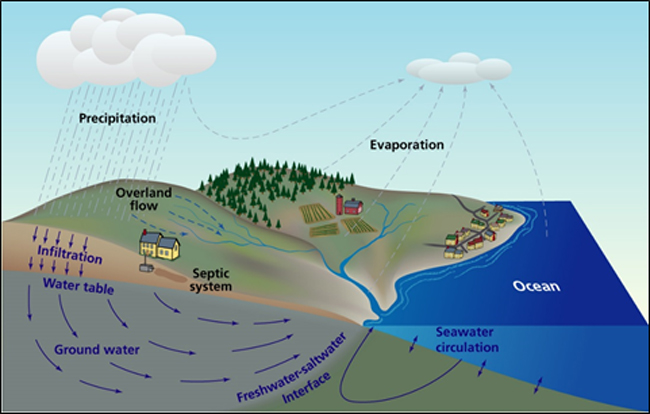
Long Island is a watershed where materials on land eventually enter groundwater and surface water. Credit: Christopher Gobler, SoMAS.
Summary
Participants learned about different factors that can affect water quality, with harmful algal bloom being the focus for this symposium. The process used to develop the Suffolk County Harmful Algal Bloom Action Plan was initiated in 2016 at a meeting facilitated by New York Sea Grant, which prefaced a year-long series of discussions with harmful algal bloom technical experts and an agency advisory group which established the scientific basis for management. Information obtained through this consultative and consensus-building process was used to identify the lead contributing causes of harmful algal blooms and recommend appropriate control and mitigation strategies.
Evidence suggests that Suffolk County is a ‘hot spot’ for harmful algal bloom occurrences, which is attributed to human-derived nitrogen inputs. The foundation of this Plan targets these nitrogen and phosphorus sources accompanied by improved monitoring, while acknowledging the compounded effects of changing climate.
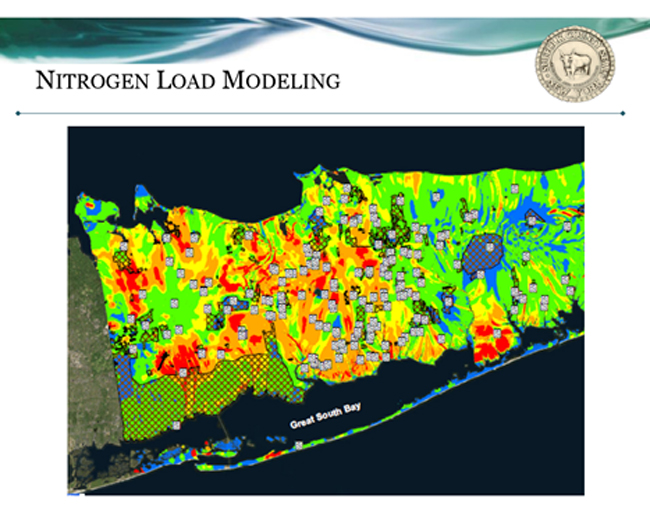
The Subwatershed Wastewater Plan models will help to predict nitrogen concentrations in the aquifer while accounting for current land use. Credit: Ken Zegel, Suffolk County Dept. of Health Services.
The Plan’s recommendations regarding nutrient input limitation and control support the County’s Subwatersheds Wastewater Plan outlining recommendations to achieve nitrogen load reduction goals through wastewater management.
The Plan recommends investing in Kelp farming to assist with excess nutrient removal through bio-extraction, and improve water quality.
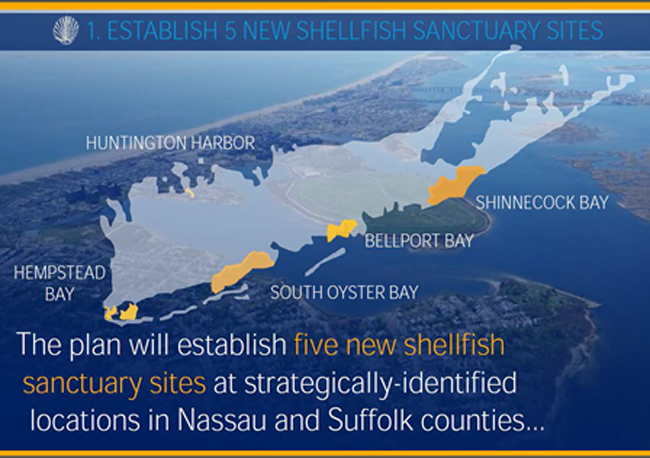
The Long Island Shellfish Restoration Project will establish strategically located shellfish sanctuary sites. Credit: Debra Barnes, NYS DEC.
Bivalves, such as clams and oysters, are filter feeders and they do a good job removing plankton from the water column. Reduced shellfish abundances may be partly responsible for the proliferation of HABs in certain County waters. The HAB Action Plan will be partially assisted through the Long Island Shellfish Restoration Project announced by the Governor in 2017 to rebuild natural shellfish beds around Long Island. This shellfish restoration effort is the largest of its kind in New York’s history, and it will be used to establish five strategically located shellfish sanctuaries, enhance capability to increase shellfish seed production in public hatcheries, resume the Raritan Bay transplant program, create a special council for shellfish restoration oversight, and streamline shellfish permitting.
Participants were informed about the 12 Priority Lakes Harmful Algal Bloom Initiative announced by the Governor in 2018. These actions being conducted by the State to address freshwater algal blooms will complement this ongoing management response in Suffolk County.
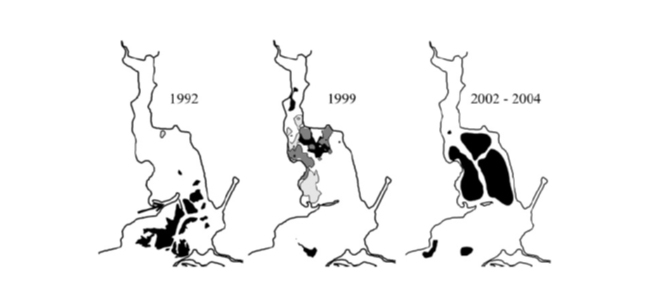
Seagrass beds in Mumford Cove, CT, displayed significant signs of recovery after a municipal wastewater treatment facility discharge was diverted. Credit: Jamie Vaudrey et al., UCONN.
Reducing the negative effects of excess nutrient loads is a challenging task and it may take several years to achieve measurable improvements in water quality. However, there is considerable evidence that ecosystems and habitats may respond positively to nutrient reduction. There has been several successes, with examples in Long Island Sound and Tampa Bay. Although recovered systems seldom to revert to their original pristine state, the public should remain optimistic based on the achievements that have been experienced in other areas.
Plenary
The best constructed management plan would be useless without having support from stakeholders, and the Suffolk County Harmful Algal Bloom Action Plan is no exception. Participants joined in a discussion about ways that stakeholders can help to advance the Plan implementation, which resulted in the following key comments and concerns:
- How does Nitrogen loading in Long Island waters compare to other estuaries
- Consider Nitrogen loading and flushing rates
- Consider the relationship among various species of Nitrogen and the occurrence of different HABs
- Explore the seasonality of Nitrogen in ground water and in water column
- Farming vs restoration: the reason why we plant clams and not oysters
- Integrating the Suffolk County Action Plan in formal education and outreach curricula
- Possible unintended consequences of nitrogen sink reinstatement, e.g., Great Lakes
- Nitrogen loading decrease from alternative septic use will be slow if replacement continues at current rate
- Teachers (middle school) want to see more resources for the classroom
- Suffolk County’s role in decreasing use of fertilizers (proposed State law)
An informal harmful algal bloom research poster display was made possible by students in the Gobler Lab.
This project is partially funded by the NOAA Ecology and Oceanography of Harmful Algal Blooms (ECOHAB) Program Award # NA17NOS4780201 to facilitate harmful algal bloom information dissemination. The statements, findings, conclusions, and recommendations on this webpage do not necessarily reflect the views of New York Sea Grant or ECOHAB.
More Info: New York Sea Grant
New York Sea Grant (NYSG), a cooperative program of Cornell University
and the State University of New York (SUNY), is one of 33 university-based
programs under the National Oceanic and Atmospheric Administration’s
National Sea Grant College Program.
Since 1971, NYSG has represented a statewide network of integrated
research, education and extension services promoting coastal community
economic vitality, environmental sustainability and citizen awareness
and understanding about the State’s marine and Great Lakes resources.
Through NYSG’s efforts, the combined talents of university scientists
and extension specialists help develop and transfer science-based
information to many coastal user groups—businesses and industries,
federal, state and local government decision-makers and agency managers,
educators, the media and the interested public.
The program maintains Great Lakes offices at Cornell University, SUNY
Buffalo, SUNY Oswego and the Wayne County Cooperative Extension office
in Newark. In the State's marine waters, NYSG has offices at Stony Brook
University in Long Island, Brooklyn College and Cornell Cooperative
Extension in NYC and Kingston in the Hudson Valley.
For updates on Sea Grant activities: www.nyseagrant.org has RSS, Facebook, Twitter, and YouTube links. NYSG offers a free e-list sign up via www.nyseagrant.org/nycoastlines for its flagship publication, NY Coastlines/Currents, which is published quarterly. Our program also produces an occasional e-newsletter,"NOAA Sea Grant's Social Media Review," via its blog, www.nyseagrant.org/blog.